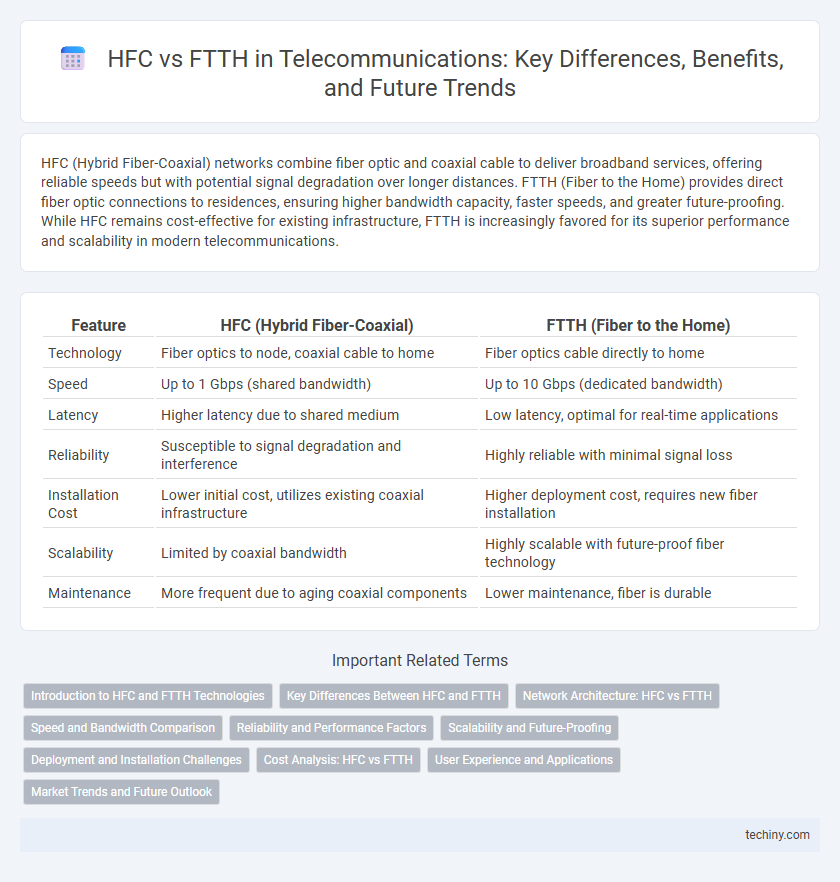HFC (Hybrid Fiber-Coaxial) networks combine fiber optic and coaxial cable to deliver broadband services, offering reliable speeds but with potential signal degradation over longer distances. FTTH (Fiber to the Home) provides direct fiber optic connections to residences, ensuring higher bandwidth capacity, faster speeds, and greater future-proofing. While HFC remains cost-effective for existing infrastructure, FTTH is increasingly favored for its superior performance and scalability in modern telecommunications.
Table of Comparison
| Feature | HFC (Hybrid Fiber-Coaxial) | FTTH (Fiber to the Home) |
|---|---|---|
| Technology | Fiber optics to node, coaxial cable to home | Fiber optics cable directly to home |
| Speed | Up to 1 Gbps (shared bandwidth) | Up to 10 Gbps (dedicated bandwidth) |
| Latency | Higher latency due to shared medium | Low latency, optimal for real-time applications |
| Reliability | Susceptible to signal degradation and interference | Highly reliable with minimal signal loss |
| Installation Cost | Lower initial cost, utilizes existing coaxial infrastructure | Higher deployment cost, requires new fiber installation |
| Scalability | Limited by coaxial bandwidth | Highly scalable with future-proof fiber technology |
| Maintenance | More frequent due to aging coaxial components | Lower maintenance, fiber is durable |
Introduction to HFC and FTTH Technologies
Hybrid Fiber-Coaxial (HFC) combines optical fiber and coaxial cable to deliver broadband services, supporting high-speed internet and video distribution over existing cable infrastructure. Fiber to the Home (FTTH) utilizes optical fiber directly to residences, enabling ultra-fast data transmission with higher bandwidth and improved reliability. Both technologies serve as critical frameworks in modern telecommunications, with FTTH offering superior performance for next-generation applications.
Key Differences Between HFC and FTTH
HFC (Hybrid Fiber-Coaxial) uses a combination of fiber optic cables and coaxial cables, delivering broadband services by leveraging existing cable TV infrastructure, whereas FTTH (Fiber to the Home) offers end-to-end fiber optic connectivity directly to residences, ensuring higher bandwidth and lower latency. HFC typically supports speeds up to 1 Gbps with potential signal degradation over coaxial segments, while FTTH provides symmetric gigabit or even multi-gigabit speeds with superior reliability and future scalability. Key differences include signal quality, network architecture, and upgrade potential, with FTTH being the preferred choice for next-generation telecommunication demands.
Network Architecture: HFC vs FTTH
Hybrid Fiber-Coaxial (HFC) networks combine fiber optic cables and coaxial cables, delivering broadband by extending fiber to a local node and using existing coaxial infrastructure for the last mile. Fiber to the Home (FTTH) architecture employs fiber optic cables directly to individual residences, enabling higher bandwidth and lower latency by eliminating coaxial segments. The pure fiber infrastructure of FTTH supports greater scalability and future-proofing compared to the mixed-media approach of HFC networks.
Speed and Bandwidth Comparison
Hybrid Fiber-Coaxial (HFC) networks typically offer maximum speeds up to 1 Gbps but can experience bandwidth sharing issues among users, leading to potential slowdowns during peak times. Fiber to the Home (FTTH) provides significantly higher speeds, often exceeding 10 Gbps, with dedicated bandwidth ensuring consistent performance and low latency. FTTH's pure fiber infrastructure supports symmetrical upload and download speeds, making it superior for bandwidth-intensive applications compared to the shared nature of HFC.
Reliability and Performance Factors
HFC (Hybrid Fiber-Coaxial) networks face challenges in reliability due to signal degradation from coaxial cable interference and network congestion, impacting overall performance. FTTH (Fiber to the Home) offers superior reliability with direct fiber connections, providing higher bandwidth, lower latency, and consistent speeds unaffected by electromagnetic interference. The pure optical infrastructure of FTTH ensures minimal packet loss and enhanced service quality, making it the preferred choice for future-proof telecommunications.
Scalability and Future-Proofing
Hybrid Fiber-Coaxial (HFC) networks offer moderate scalability by upgrading existing coaxial infrastructure but face limitations in bandwidth expansion compared to Fiber to the Home (FTTH) solutions. FTTH provides superior future-proofing due to its ability to deliver ultra-high-speed broadband with virtually unlimited capacity through direct fiber connections. Investment in FTTH infrastructure ensures adaptability to emerging technologies like 5G and IPTV, supporting long-term network growth and enhanced user experience.
Deployment and Installation Challenges
HFC deployment leverages existing coaxial cable infrastructure, reducing upfront costs but faces challenges with network maintenance and signal degradation over long distances. FTTH requires extensive fiber-optic cable installation directly to premises, demanding significant civil works and higher initial investment. Both technologies contend with regulatory hurdles and the complexity of urban vs. rural deployments, impacting rollout speed and scalability.
Cost Analysis: HFC vs FTTH
Hybrid Fiber-Coaxial (HFC) networks typically incur lower initial deployment costs compared to Fiber to the Home (FTTH) due to existing coaxial infrastructure utilization. FTTH requires substantial capital expenditure for fiber optic installation and customer premises equipment but offers lower long-term maintenance and operational costs due to fiber's durability and higher bandwidth capacity. Cost analysis should consider total cost of ownership, including future scalability, network reliability, and service quality impact on customer retention.
User Experience and Applications
Hybrid Fiber-Coaxial (HFC) networks provide reliable broadband with sufficient speed for typical streaming and web browsing, but Fiber-to-the-Home (FTTH) delivers ultra-high-speed connections that significantly enhance user experience for bandwidth-intensive applications such as 4K/8K video streaming, cloud gaming, and virtual reality. FTTH's symmetrical upload and download speeds reduce latency and improve the performance of real-time interactive services, making it ideal for teleconferencing and remote work environments. HFC's shared bandwidth architecture may lead to network congestion during peak usage times, while FTTH offers dedicated fiber lines that ensure consistent and scalable performance for evolving digital demands.
Market Trends and Future Outlook
The telecommunications market shows accelerating demand for FTTH (Fiber to the Home) due to its superior bandwidth and lower latency compared to HFC (Hybrid Fiber-Coaxial) networks, supporting increasing adoption of streaming, gaming, and smart home applications. Market forecasts predict FTTH deployments will grow by over 15% annually, driven by government initiatives and consumer preferences for symmetrical gigabit speeds. Despite HFC's widespread legacy infrastructure, innovation in DOCSIS 4.0 technology delays decline, but long-term outlook favors FTTH as the dominant broadband architecture for 5G backhaul and next-generation connectivity.
HFC vs FTTH Infographic

 techiny.com
techiny.com